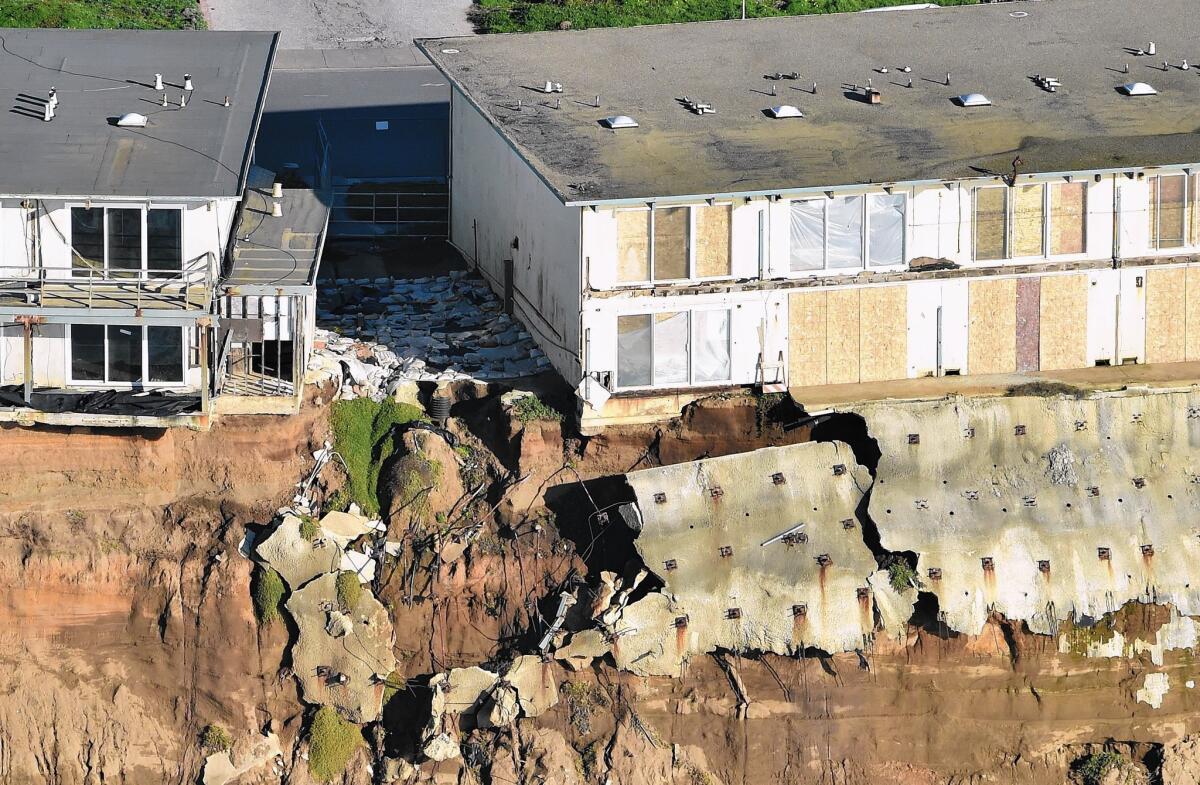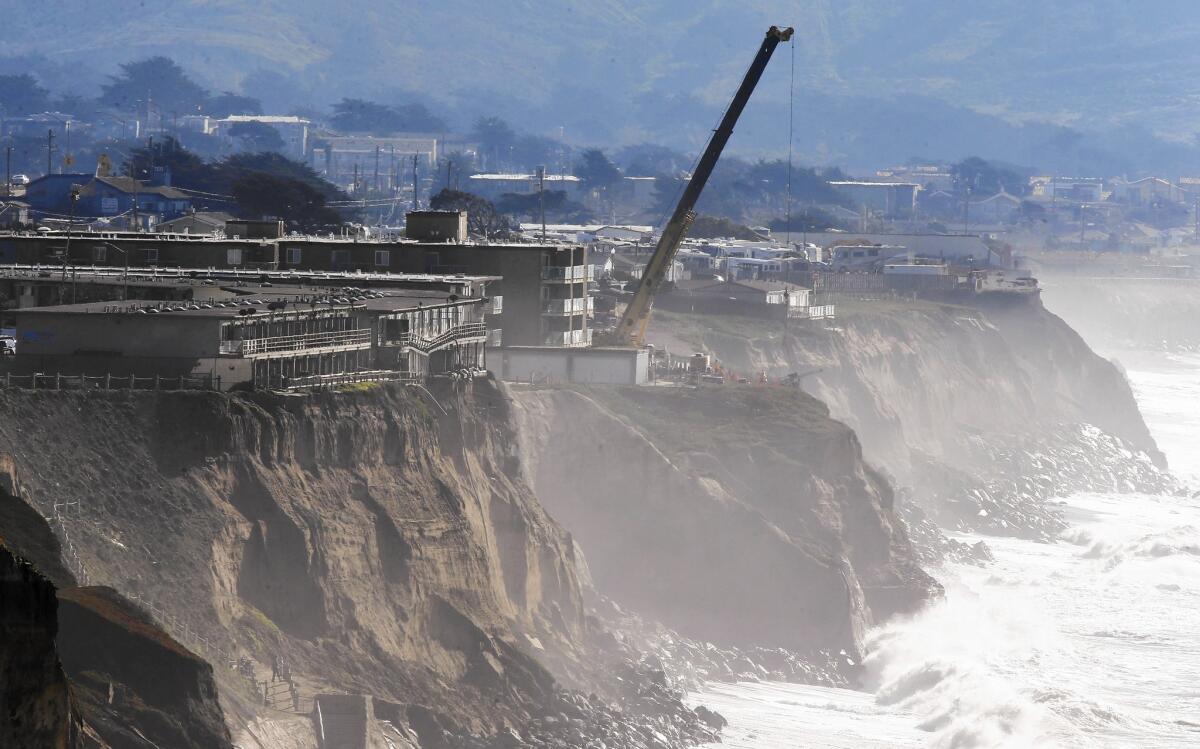A coastal town’s long and stormy relationship with El Niño

- Share via
Reporting from Pacifica, Calif. — In an old shingled house on Beach Boulevard, salt water sprays the living room windows above the garage. Pam Raymond looks out to see 20-foot gray waves cannonading the underside of the town’s fishing pier. When a bigger one thumps a quarter-mile out, she can feel a faint rumble in her floorboards.
Whitewash hits the sea wall across her street and spews sand, rocks and bits of seaweed into her neighborhood. In her front garden, only succulents can survive these deluges of brine.
Raymond’s house is not far from a Safeway and a Taco Bell, but on winter days like this, the town feels like a remote outpost against the ocean.
Waves gnashed out a section of the sea wall last week and are threatening to eat parts of the street it protects. Since December, storm surf has damaged the end of the concrete pier and carved away sandy cliffs. Officials condemned one apartment building — next to two others that had been evacuated in 2010 — and at least two homes.
El Niño is an abstruse phenomenon far easier to predict on a global scale than a local one.
But just south of San Francisco, Pacifica has come to know it intimately — with both awe and dread.
“I worry about it all the time,” said Raymond, 51. “It’s been rumbling at night. A real loud rumbling that keeps you up.”
These bluffs have been hammered by the ocean for millenniums. What makes Pacifica — a string of seaside hamlets along six miles of coast — so vulnerable is that the land is loose.
Tectonic stresses in this northern spur of the Santa Cruz Mountains have fractured and ground down granite, shale and sandstone into rock fragments that don’t compact as well as soil. And some of the coastal bluffs are composed of little more than sand.
The Italians who settled here a century ago liked the sandy soil to grow artichokes. But the loose sediment has bedeviled nearly everyone else.
At the infamous Devil’s Slide on the south end of town, a harrowing stretch of Pacific Coast Highway collapsed into the sea in 1940, just three years after it was built, and did so again seven more times before the state finally replaced it with twin-bore tunnels in 2013.
In wet winters, rain sets off debris flows and floods the valleys, as waves tear away at the coast.

The two biggest El Niños on record hit hard. On Jan. 4, 1983, more than 5 inches of rain fell in one day. Residents in canoes paddled out of flooded homes in the San Pedro Valley. A mudslide at the top of the valley plowed into three homes, killing three children sleeping in their beds.
The 1997-98 El Niño saw seven homes on Esplanade Avenue lose the last 10 feet of their backyards, and the residents had to evacuate.
Storms in the 2009-10 winter, a moderate El Niño, forced officials to red-tag two apartment buildings on Esplanade at the edge of a 70-foot cliff. According to the California Coastal Commission manager for the district, Nancy Cave, the owners of the buildings obtained emergency permits in 2003 to drop boulders at the base of the cliff to keep the waves from eating it away. They were required to come back with plans for a permanent fix but never did.
Geological maps indicate that the apartments, built in 1962, are sitting on “dune soil.” A photo of them taken in 1972 shows the bluff extending much farther out, sloping down, with only a band of vertical sandstone in the middle. Over the next 40 years, the water ate at the base until parts of the cliff were plumb-line-straight, from back patio to the high-tide line.
One building retained enough of a setback to remain occupied for a spell, even as the dicey situation kept rents low. For taking the risk, Section 8 and other low-income residents got phenomenal ocean views.
The beach used to go way out there. I feel like we’re living on borrowed time.
— Pam Raymond, a resident of Pacifica
But last week a drone video showed huge chunks of sand sloughing off beneath them, creating cavities in the cliff. On Jan. 25, city officials told the 26 residents of 310 Esplanade they had to move.
Some were still clearing out Friday as the waves pounded below.
Down the street, John Entwistle, 51, roamed the high dunes with his dogs in a light rain.
Hearing that waves might reach 30 feet, he and his two housemates drove down from the Castro District in San Francisco to see the spectacle.
The big pewter waves and misty sky reminded Entwistle of a William Turner seascape.
They watched work crews unload boulders, to be used to shore up the cliff below different properties.
“It’s hard to believe the impact on these cliffs,” he said.
Raymond and her husband, John, think about moving out of the home they’ve lived in for 25 years. Built in the 1930s, it has the feel of a whaling station, and it has weathered plenty of storms. She loves the view, loves when the whales surface and blow. Watching the storms roll in while she sips coffee or wine by the fire is an epic feeling: an element so outside of human scale, bellowing right outside her window. “We’re definitely on the edge here.”
But she would like to garden someday, planting something other than succulents. She dabs at salt crystals clustered in the corner of her window and says she’s sick of replacing the windows. Everything rusts and rots like an old fishing boat. John had to put up sandbags to keep the water out of the garage, but it only slows the flooding. Waves that have already blown over a 10-foot sea wall and across the street are bound to get over sandbags. She’s seen waves shove cars into the curb and knock countless people over. Once they whipped her mother’s glasses off.
And she says it’s getting worse as the seas rise.
“The beach used to go way out there,” Raymond said. “I feel like we’re living on borrowed time.”
A block down, Paul VanWambeke, 75, chortles as three teenage boys are caught off guard by an explosion of water and flee as if a shark had lunged over the wall.
As a local since 1968, VanWambeke admits he got nailed once. He loves the ocean but lives up the hill, where he doesn’t have to worry about his property getting swallowed by the Pacific.
“Down here it’s like living next to a volcano,” he said. “I can walk to the beach.”
Join the conversation on Facebook >>
ALSO
Winds topping 115 mph hit Southern California; 1 killed when tree falls on car
Metrolink delays nearly doubled last year, records show
As USC faculty awaits results of a union vote, some hope for ‘a bigger voice’







